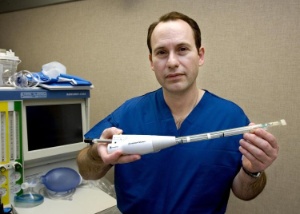Stanford hospital performs stomach surgery through throat
16 February 2009
A 53 year old man has become one of the first patients at Stanford Hospital & Clinics in the US to be treated using what is called natural orifice surgery, in this case for weight-loss. The entire surgery was performed through the man's throat.
“We went down his throat with a device that looks like a regular endoscope, with a ‘duckbill’ on the end,” the surgeon, John Morton, MD, said. “In the duckbill is a tiny instrument like a sewing machine, with a needle that has plastic sutures.”
“I woke up with just a slight sore throat,” said the patient, Paul Martin about the procedure, which took about two hours. “There wasn’t any pain because there weren’t any incisions.”
In the operation — a stomach plication procedure called Stomaphyx—no trace was visible after Morton inserted the instruments down the patient’s throat. Indeed, Martin called it a “tune up” to correct a slight weight gain he experienced after his 2006 gastric bypass surgery.
Dr Morton, who is also associate professor of surgery, stitched pleats in the stoma, the opening between the patient’s intestine and the small pouch that had been created in the earlier surgery. He then tightened the pleats around the endoscope, reducing the stoma from 20 millimeters to 14, helping to control the amount of food Martin could digest.
Before the first operation, Martin said, he “huffed and puffed” and had to use an electric cart to get around the construction sites he manages. Now he walks those sites and climbs stairs. Since December, he has lost 17 pounds.
After the operation two years ago, Martin had initially lost more than 150 pounds, before regaining some weight. Such weight regain is rare, noted Morton. Of the 1,200 procedures he has performed, he said, only 20 patients have regained more than five percent of the weight they lost. “But obesity is a chronic disease, and there can be relapses,” he added. “So you find options for patients.”

Figure 1. The endoscope used to perform the natural
orifice operation
Morton described the procedure he performed as part of a continuum of evolving practices. “They’re innovations in what I call ‘minimal access’ surgery,” he said. “We’re moving away from small, multiple incisions, to just one scar or, in some cases, no scar. It’s something we can offer that hopefully will decrease pain and allow for quicker recovery.”
As Morton and other surgeons at Stanford continue to refine no-scar and single-incision procedures, he predicted that more flexible instruments, which will help surgeons work in smaller areas and around corners, will be developed. “That’s a prime direction for the hospital’s Surgical Innovations Program, that we look for new tools and new technologies to help us perform these procedures,” he said.
Other bodily openings that surgeons nationwide have used for natural orifice surgery include the mouth, vagina, rectum and penis. Instead of taking out gall bladders through painful incisions in the abdominal wall, for example, surgeons have removed the organs through these so-called natural orifices, reducing patients’ pain and recovery times.
For another patient who wanted weight-loss surgery, Morton, a specialist in bariatric surgery, chose a different approach. David Pierson, a 32-year-old construction supervisor who had struggled with obesity since he was 12, was a good candidate for lap-band gastric bypass surgery. The twist? The entire procedure was performed through one small incision in the patient’s belly button — the first such surgery in Northern California.
Morton inserted the laparoscopic instruments and camera required for the lap-band procedure through Pierson’s belly button, which he calls an “ideal” entry point. “The instruments went in one direction — up. The only challenging part was tying knots on the inside. But it was pretty smooth, and looks great,” he said. “We know that one incision is less painful than four or five, and the lower the incision, the less the pain.” By going through the belly button, he avoided making a larger incision closer to the rib cage, which would have caused pain because of the muscles pulling on it.
Pierson said he woke up from the two-hour surgery feeling like his stomach “had been worked on — like I’d been trying to do crunches.” He spent one night in the hospital and returned to work the following week. “I couldn’t see the incision for two days,” because of a bandage, Pierson recalled. “But when it came off, it just looked like little stitches.”
Bookmark this page